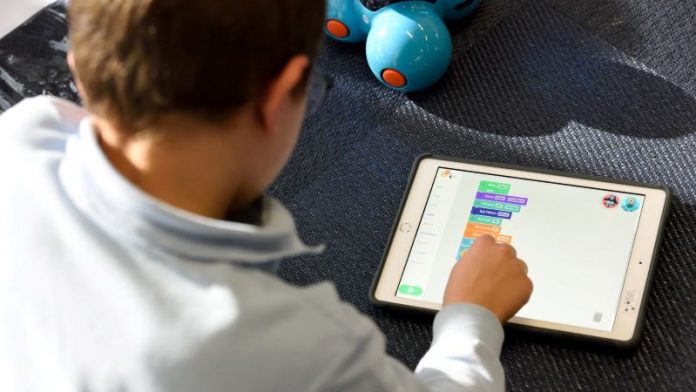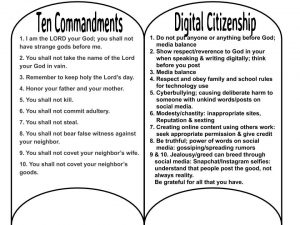
Discussing the moral use of technology within religious instruction
ANNABEL DOTZMAN
Take a moment to think about your daily routines. Technology, intrinsically neither bad nor dangerous, is integrated into every aspect of our lives. But as with many things, it is what we do with technology that makes a difference. Combined with the reality that children are gaining online access at younger ages, when and how do they learn to become responsible digital citizens? As we begin to explore this issue, let’s first examine what it means to be a digital citizen and how this fits in with Catholic teaching.
What is digital citizenship?
Children’s first teachers are their parents, from first steps to first prayers. When children enter our classrooms, the primary focus of catechesis is to equip saints for this life and the next. No one can accurately predict what the future will be like for our youngest students. The only certainty is that technology will be a large part of it, so we strive to educate students for their future, not ours. We instruct students in Church teaching throughout their time with us, and we guide them in developing character and a moral compass. With today’s increased technology use, we must guide them in applying these same values to their reality of being a part of a connected, global world. This is the essence of digital citizenship. Digital citizenship is having the skills and knowledge to think critically, behave safely, and participate responsibly in the digital world.
Partnering digital citizenship and faith formation
Education and formation in the Catholic faith is a lifelong, multidimensional process (see National Directory for Catechesis, USCCB, 2005). To develop a healthy, faith-filled lifestyle, children need the support of the many people in their lives, including parents, educators, and others who have an influence on their development. But it would be remiss to separate or leave out “digital” from the lifestyle description.
Students’ online behavior can greatly impact the learning environment. Parents often reach out to teachers and administrators for support. One suggested resource is CommonSenseMedia.org. Common Sense Media (CSM) offers resources for educators and families to help students navigate the digital world.
Within the Archdiocese of Philadelphia, CSM’s Digital Citizenship curriculum (go to CommonSense.org/education/) has been adopted as the primary resource for digital citizenship instruction. Digital citizenship lessons usually focus mainly on digital footprints and online safety, but with the rise of online bullying and screen addiction, CSM recognized the need to broaden the scope. They recently updated their curriculum to include topics such as media balance, cyberbullying, and news and media literacy. This provides the opportunity for digital citizenship to be woven into everyday instruction to help students establish healthy digital habits.
A common misconception is that digital citizenship instruction is a stand-alone program. Often one teacher is responsible for planning and delivering lessons. However, to be effective, digital citizenship skills should not be presented solely in isolation. Rather, informal discussions should be integrated daily and connected throughout all subjects, including religious instruction. Students are taught right from wrong and how their conscience guides them in choosing their words and actions. If we shift our mindset to correlate digital citizenship with moral character, discussions, and learning should happen naturally throughout all classrooms.
 The Ten Commandments can naturally serve as an entry point for digital citizenship conversations. The Fifth and Eighth Commandments could generate discussions on cyberbullying and social media use. Connections to copyright laws and citing online sources could be made through the Seventh Commandment. We could also showcase how technology can be used for evangelization, such as Pope Francis’ social media presence. Educators should also be mindful to be model digital citizens themselves. To truly equip our future saints, all educators are called to foster and develop digital citizenship regardless of whether they teach or use technology in their classrooms.
The Ten Commandments can naturally serve as an entry point for digital citizenship conversations. The Fifth and Eighth Commandments could generate discussions on cyberbullying and social media use. Connections to copyright laws and citing online sources could be made through the Seventh Commandment. We could also showcase how technology can be used for evangelization, such as Pope Francis’ social media presence. Educators should also be mindful to be model digital citizens themselves. To truly equip our future saints, all educators are called to foster and develop digital citizenship regardless of whether they teach or use technology in their classrooms.
References
■ Advanced Solutions International, Inc. “Overview.” NCEA and Catechesis, NCEA,
2018, CATmag.us/2OVgH2u
■ “Digital Citizenship.” Common Sense Education, Common Sense, 31 July 2019, CATmag.us/2YZlO5j
■ Student, parent, teacher triangle. Digital image. Arrow Academic Center CATmag.us/2Z1Srvd
Annabel Dotzman is a technology integration coach for the Archdiocese of Philadelphia. She provides training and support for the integration and best practices use of educational technology across the curriculum. Prior to this position, Annabel was an elementary classroom teacher in the archdiocese for eight years. She has presented at several conferences, including NCEA, ISTE, and Pete&C.
This article was originally published in Catechist magazine, November/December 2019.




